On View
Peer Inside the Prison of the Belgian Pavilion at the Venice Biennale and See a Disturbing World of Mannequins and Old White People
Belgian duo Jos de Gruyter and Harald Thys are sending the Europe's idealized archetypes to jail.
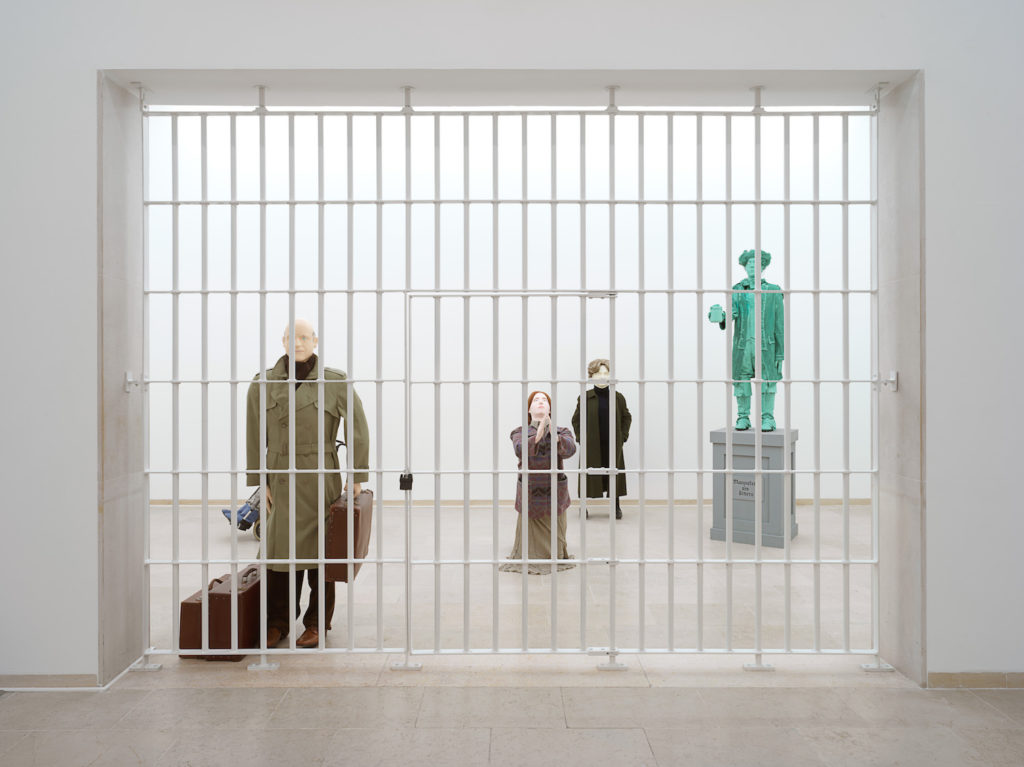
Belgian duo Jos de Gruyter and Harald Thys are sending the Europe's idealized archetypes to jail.

Kate Brown

The best-known landmark in Brussels is a diminutive fountain statue of a cherub peeing into the city’s waterway. Several times a week, the boy is dressed up in costumes as per a publicized schedule. Reimagined in magnets and postcards, proliferating on tourists’ refrigerators worldwide, this historic emblem of Belgium (Manneken Pis, or the “little pisser”) taps into a particularly Belgian way of thinking: it’s a bit weird, a bit disturbed, and doesn’t take itself too seriously.
The Belgian duo Jos de Gruyter and Harald Thys work along these same lines: they dress up their friends and family for their films and costume life-sized puppets for their installations to weave them into darkly twisted storylines that take the piss out of European idealism. For their latest show, which takes over the Belgian Pavilion at the Venice Biennale (the oldest venue in the Giardini), the duo is taking another stab at the continent’s identity.
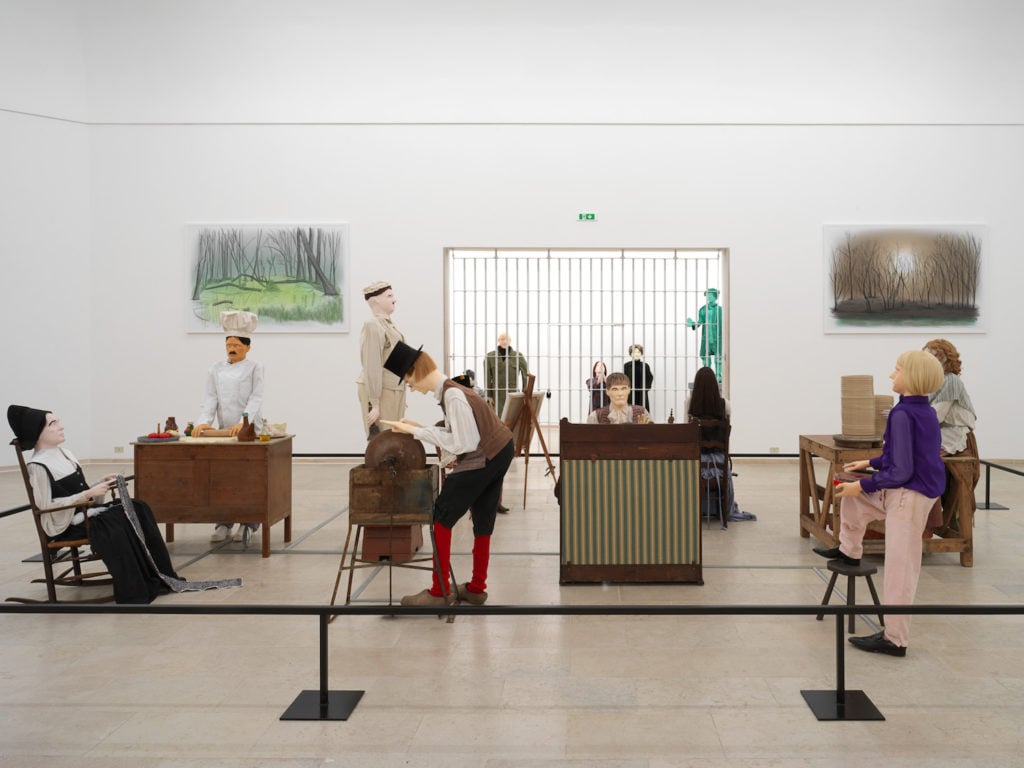
A view of Jos de Gruyter and Harald Thys’s exhibition, “Mondo Cane,” in the Belgian Pavilion at the Venice Biennale. Courtesy and copyright of the artists and the Belgian Pavilion. Image: Nick Ash.
But this presentation—which they call a single artwork, and which they have designed as a multi-roomed jail populated by their atypical cast—looks at ye old pastoral Europe, and each of the folkloric figures they’ve made is toiling away in perpetuity at their obsolesced craft of choice.
Of their 20 puppets in Venice—which are, for the first time, robotized—several are trapped in a loop, unable to escape “old patriarchal ‘safe’ society, with rules that are no longer valid,” say the artists (who speak as one). The dedicated workers of lost Europe are locked in but busy: there is the chef, the seamstress, the musician, and the knife grinder, propped as figures of the lost past so championed in the West.
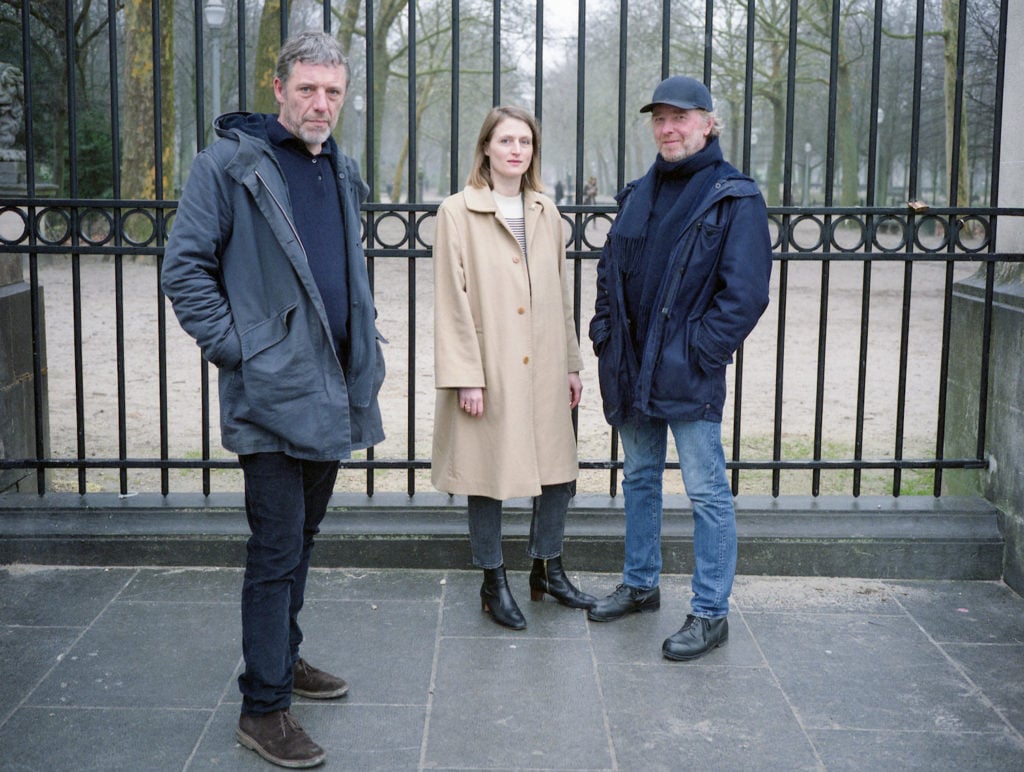
Jos de Gruyter (left) and Harald Thys (right) with Anne-Claire Schmitz, curator of the 2019 Belgian Pavilion. Copyright and courtesy the artists. Image: Margaux Nieto.
Jos de Gruyter and Harald Thys have long mined the nuances of the old world, which is predominantly white in all its self-aggrandizement, failure, and lore.
Over the course of their three-decade collaboration, the artists have streamlined a brilliant but unsettling art practice that has been translated into oddball watercolor works, creepy portraiture, and—pretty consistently—psychotic or autistic characters, which can be either actors or puppets. In their show “White Suprematism” at Frankfurt’s Portikus exhibition hall in 2016, they packed the space full of clusters of white steel sculptures onto which were tacked thinly sketched faces of random, unremarkable people. The show was something between a mausoleum for the lowest common denominator and a scaled down cityscape to host them.
While they are clearly enjoying what they do (“we have a lot of fun,” they tell me), they do not seem especially optimistic. The two describe the current mood in Europe as similar to “a giant burn out” or a general “depression.” They explain over email from Venice that their barred installation, called “Mondo Cane,” is a critique of safe society overall.
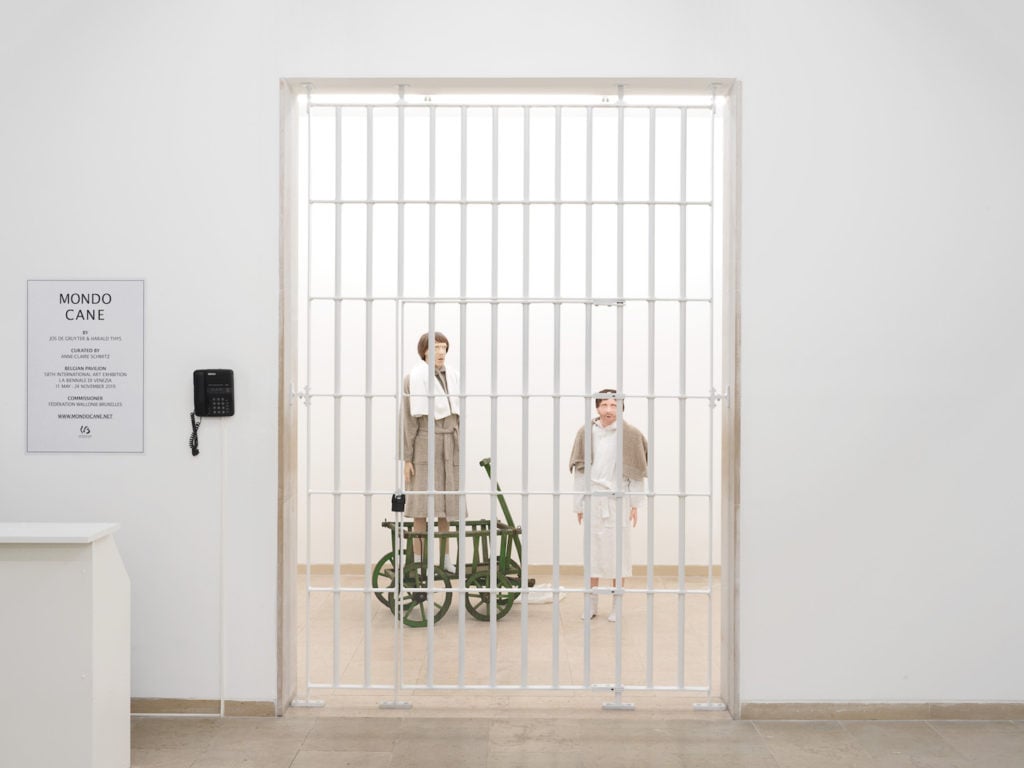
The characters “Flap” and “Flop” in De Gruyter and Thys’s exhibition, “Mondo Cane,” in the Belgian Pavilion at the Venice Biennale. Courtesy and copyright of the artists and the Belgian Pavilion. Image: Nick Ash.
And outside the confines of picturesque Venice, safety is a point of concern, especially in the wake of the so-called migrant crisis and in light of the European parliamentary elections coming up later this month. Some fear that more xenophobic nationalists will make gains in Brussels, where the European Union is headquartered, and where De Gruyter and Thys live and work.
“The burning of the Notre Dame in Paris was a huge drama but the timing was perfect. We could all mourn and be sorry because it was in the heart of Europe,” they say. “In a few days they had more than a billion to rebuild it better than before. The event catalyses a lot of feelings of guilt, and it looked a bit like a purification ritual for the old world. When Palmyra was destroyed by ISIS, the reactions where somewhat different.”
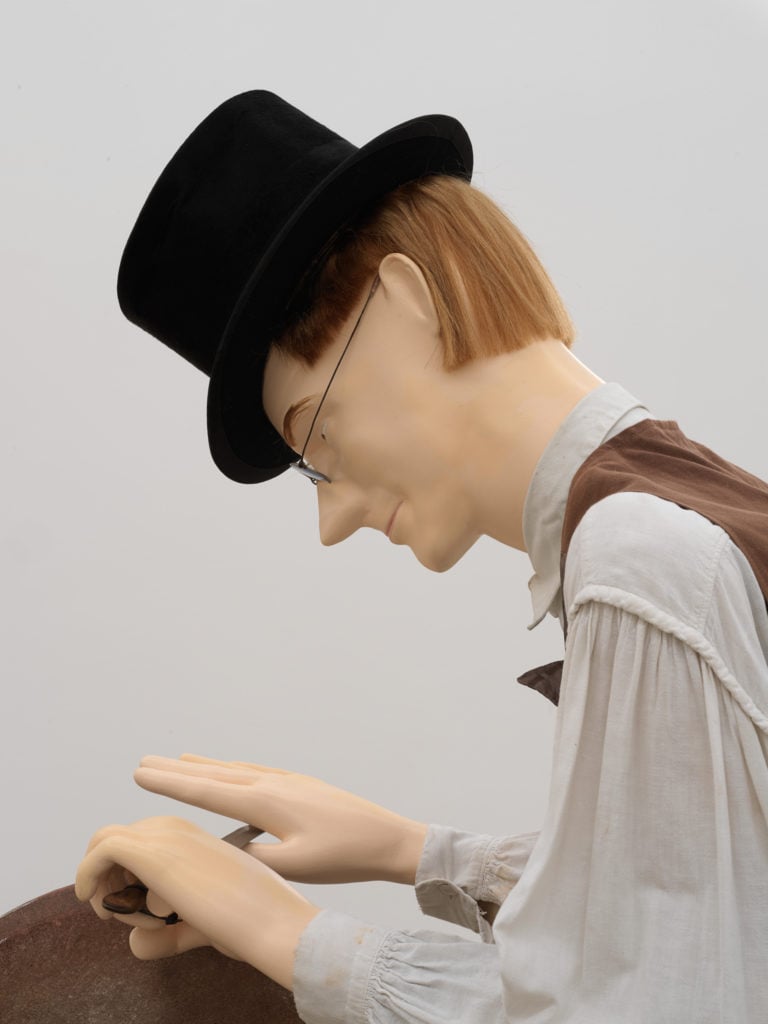
“The Knife Grinder” in De Gruyter and Thys’s exhibition, “Mondo Cane,” in the Belgian Pavilion at the Venice Biennale. Courtesy and copyright of the artists and the Belgian Pavilion. Image: Nick Ash.
In concrete terms, the show takes its cue (and title) from the Italian (and mostly real) documentary Mondo Cane. The 1962 film, known in the US as Tales of the Bizarre: Rites, Rituals and Superstitions, is a sequence of staged and real vignettes from around the world that explore the bizarre, ugly, and sometimes gory recesses of human behavior.
“Back in the eighties, we had a VHS tape of Mondo Cane and we kept on watching it,” the duo says. They were fascinated by their inability to know if what they were seeing was real. “The way the world is depicted by clichés, sensational stories, and weird happenings is edited in a very clever way. The spectator enjoys looking at the weird world full of mean things, but can turn it off whenever he wants and hide the VHS tape under his bed.”
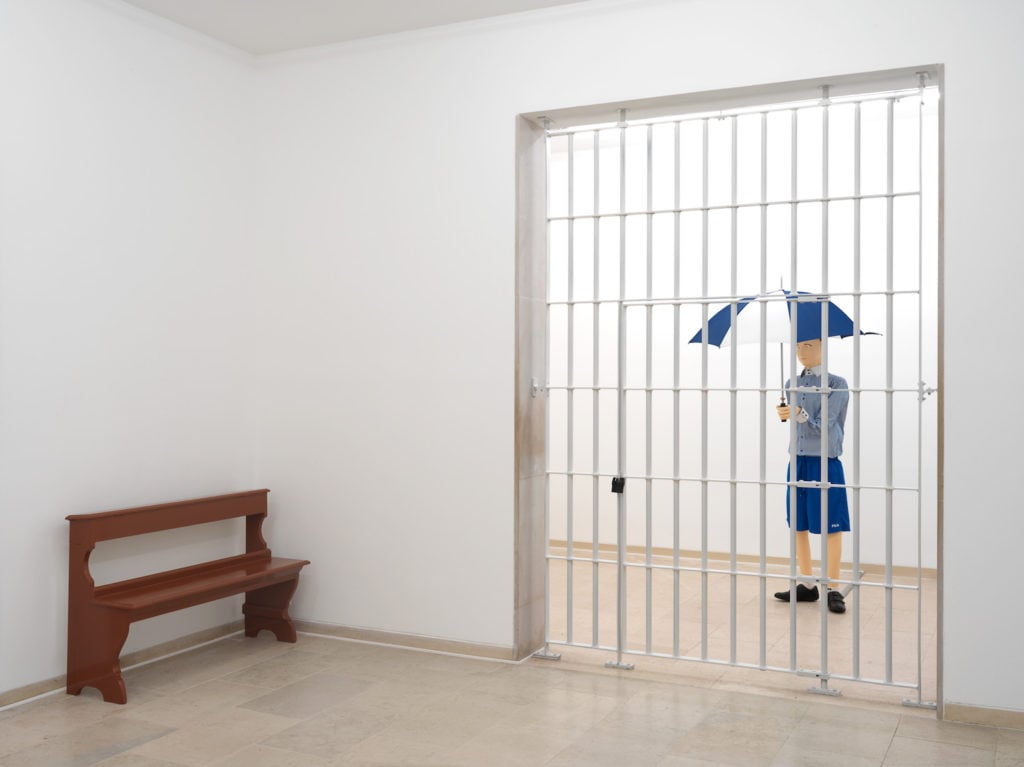
A character called “The Fool” in De Gruyter and Thys’s exhibition, “Mondo Cane,” in the Belgian Pavilion at the Venice Biennale. Courtesy and copyright of the artists and the Belgian Pavilion. Image: Nick Ash.
The current situation in Europe is weird in its own way. “The high standard of living creates a kind of autism,” say De Gruyter and Thys. “Design, cuisine, pottery, local vegetables, and vintage [things] become very important topics. People ‘design’ their life in order to have an identity. The ‘old Europe’ can be incredibly sad and nostalgic. It is an aging society that will vanish if it doesn’t reinvent itself.”
In their work for the Belgian Pavilion, De Gruyter and Thys’s dolls are, as usual, very pallid. Their dysfunctional world that is male, pale, and totally sad (though, regarding gender, they point out that half their cast is female).
And who is outside the jail cell, running free? The crazy ones, of course. There is “The Fool,” who, according to the visitor guide, has the mental capacity of an eight-year-old, despite being an adult. There is “The Rat Woman,” a harbinger of death who comes to you when you are alone in the dark. Another one, “Franceleine de Veugeleir,” has spent her whole life wishing she was never born.
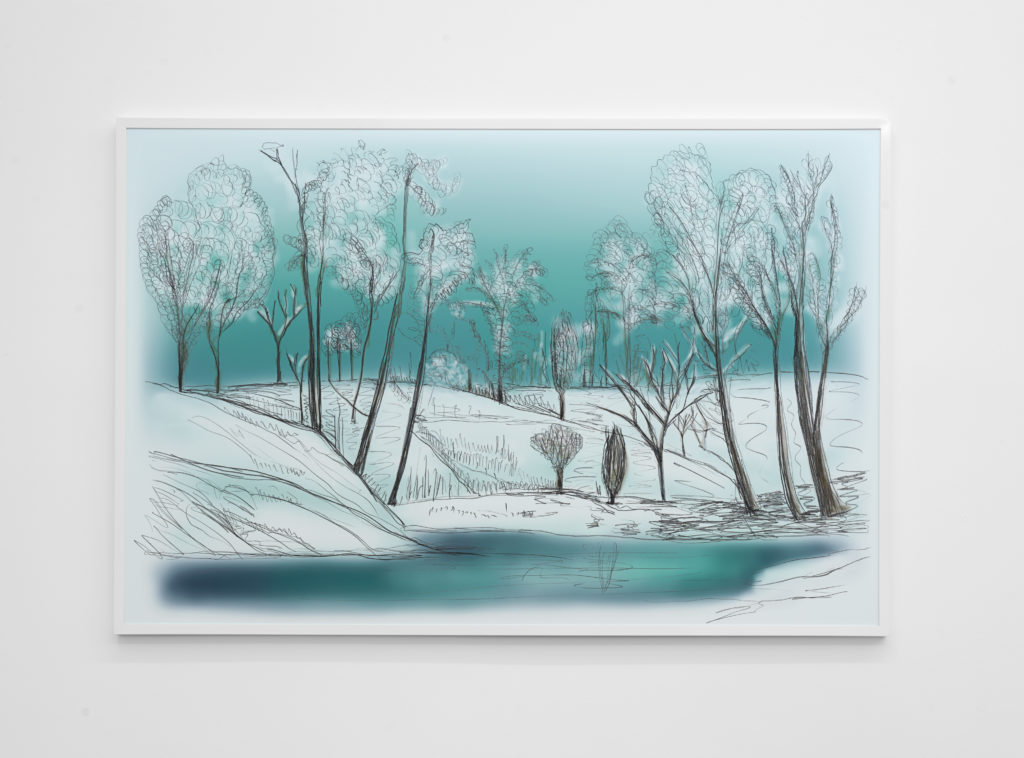
“Landscape,” a work in the exhibition. Courtesy and copyright of the artists and the Belgian Pavilion. Image: Nick Ash.
“This very safe society is under attack by uncanny creatures like witches, retarded individuals, religious fanatics, beggars, and ghosts,” the artists say of their installation. “The inhabitants try to stick to their tasks and habits but get very scared.” It’s all about European decay—a world as old as it is pathetic.
The trance-like monotony of the figures’ small robotic movements is due to a fear-induced paralysis, say De Gruyter and Thys. “They know they will be invaded one day, but for the time being, they will function like they have for hundreds of years—in a circular way. They have become the victim of their own fear.”
“Mondo Cane” will be on view at the Belgian Pavilion from May 11 to November 24, 2019 at the 58th International Art Exhibition, La Biennale di Venezia.